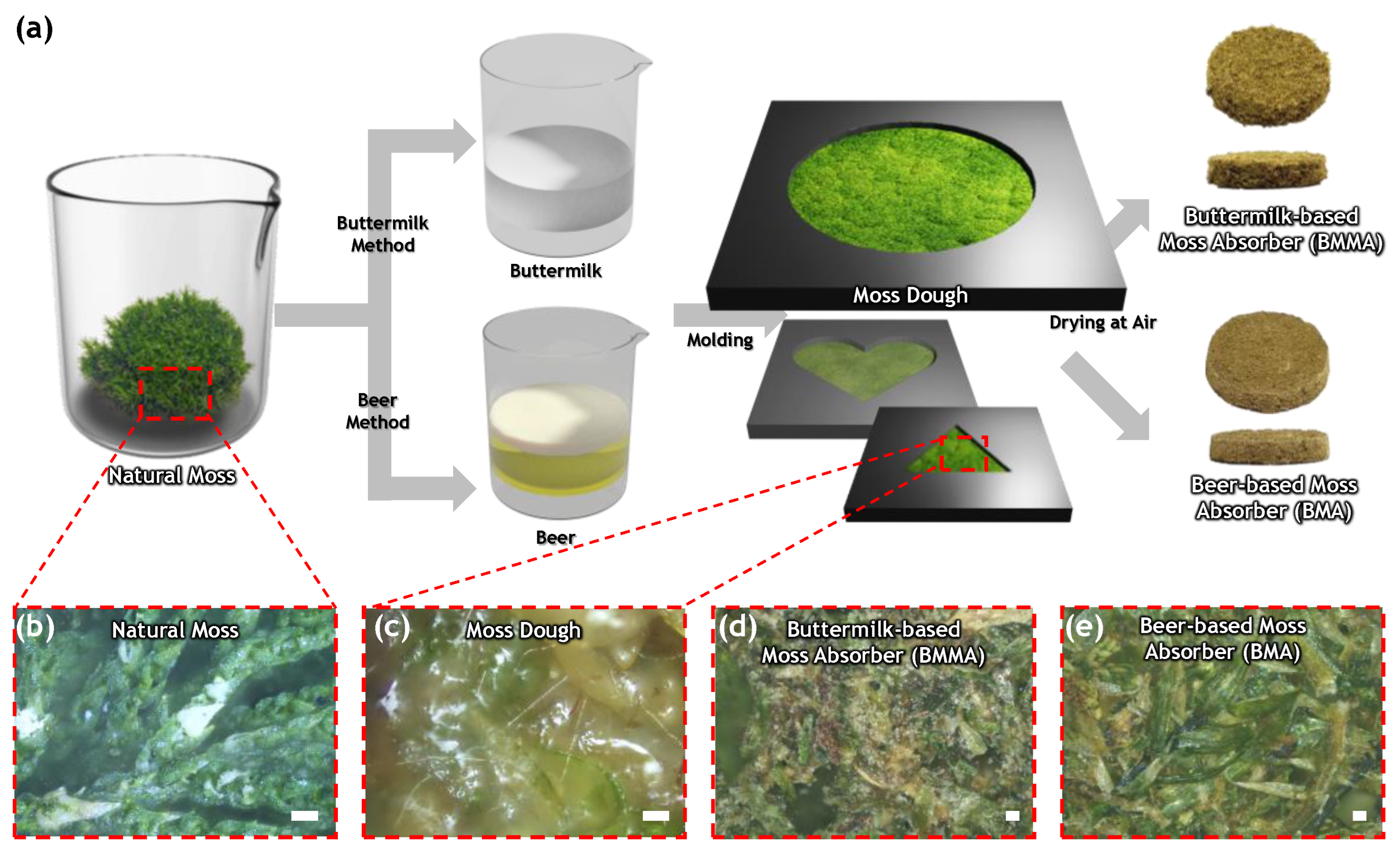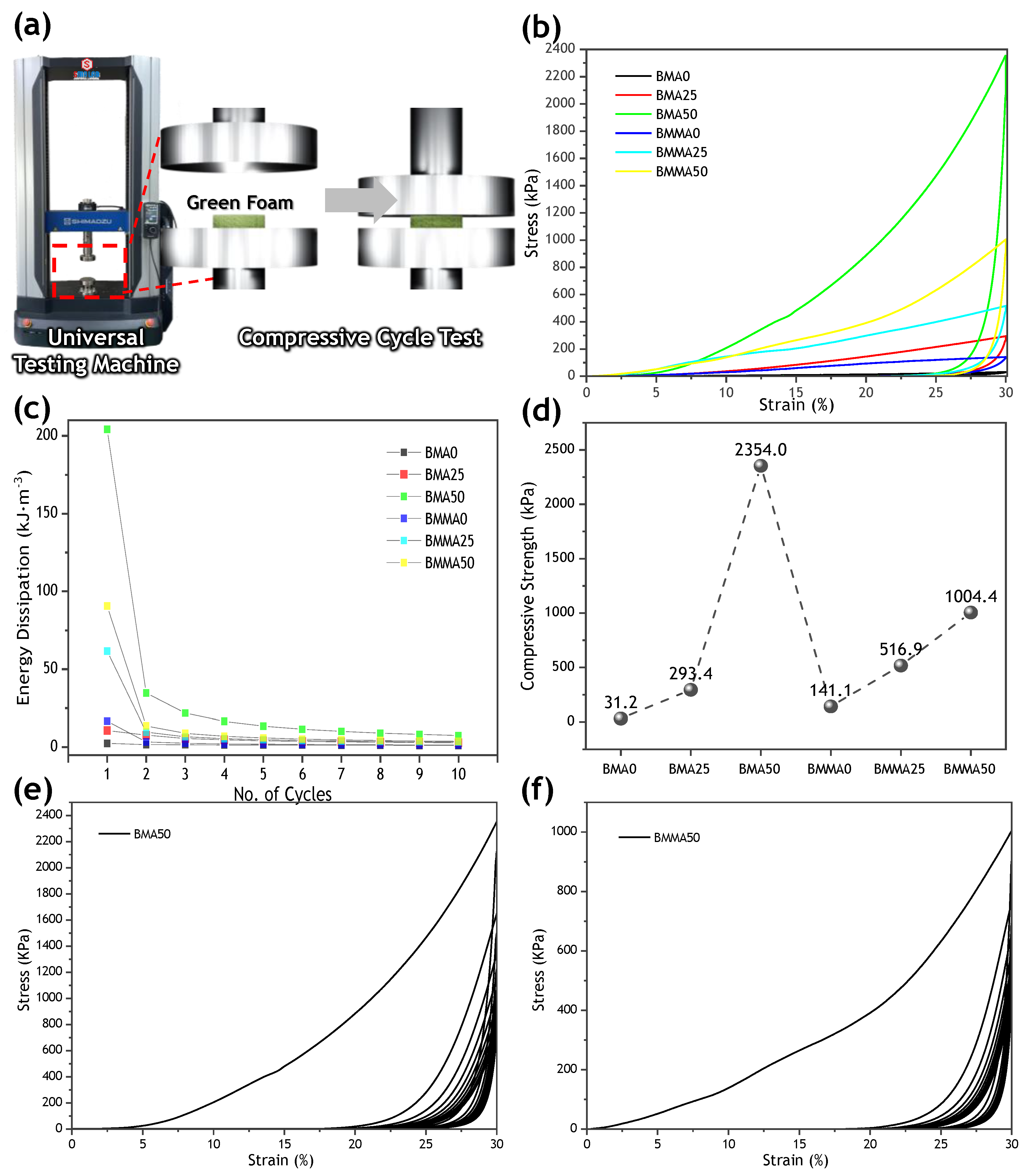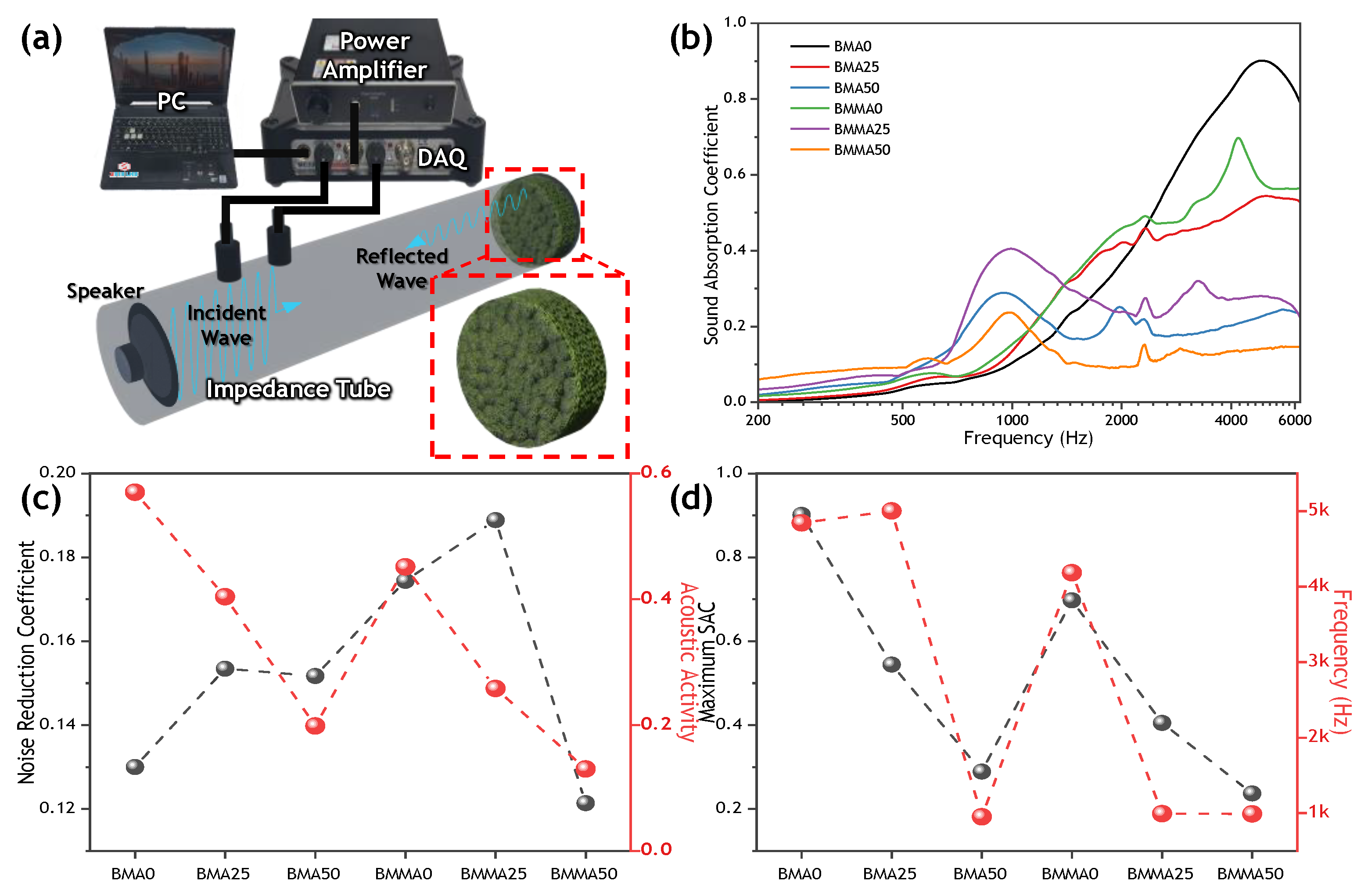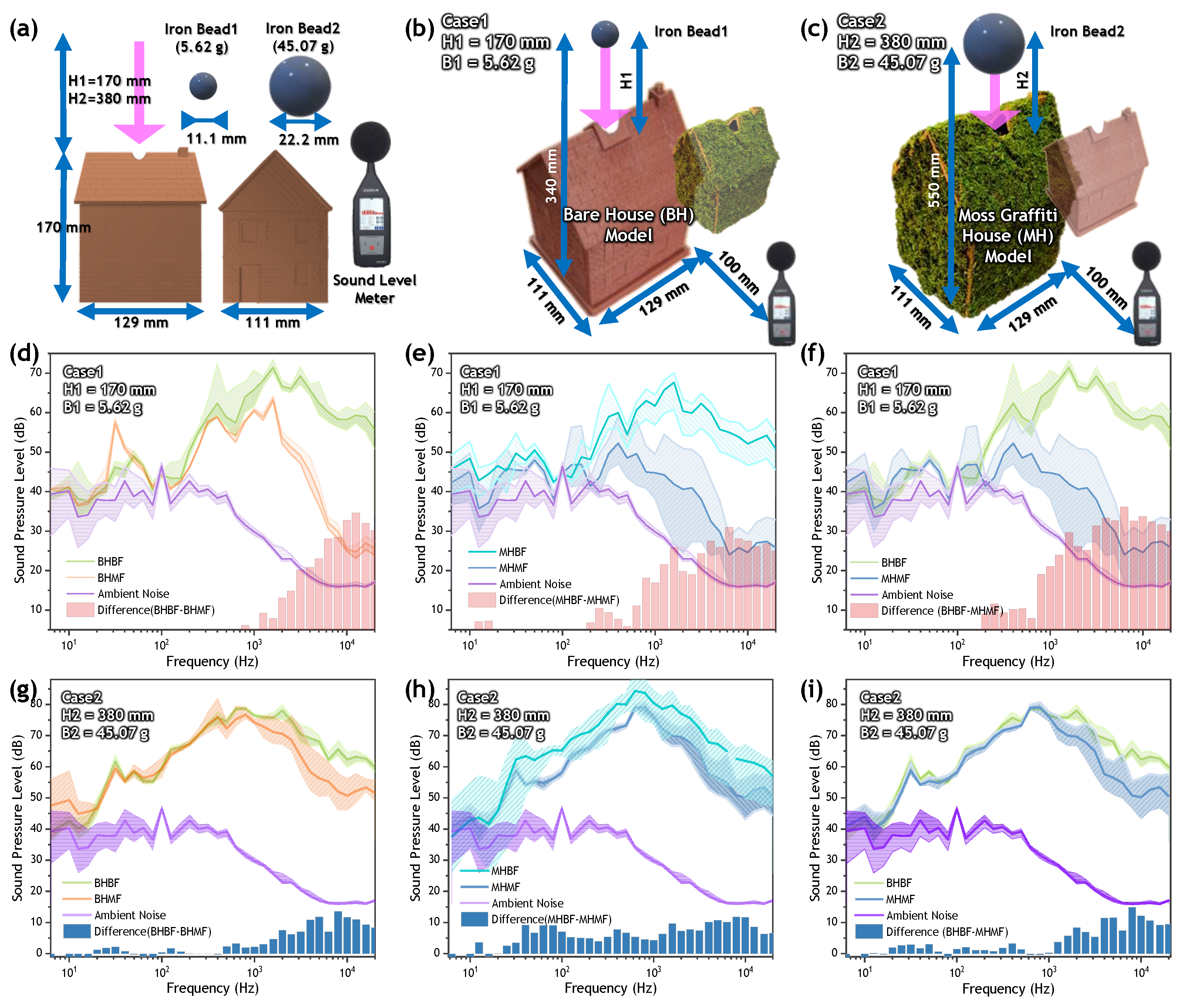All-Natural Moss-Based Microstructural Composites in Deformable Form for Use as Graffiti and Artificial-Porous-Material Replacement
Abstract
1. Introduction
2. Materials and Methods
2.1. Material Design and Fabrication Strategy
2.2. Mechanical Performance
2.3. Sound-Absorption Performance
2.4. Impact of Sound-Absorbing Performance
3. Results
4. Discussion
Author Contributions
Funding
Institutional Review Board Statement
Informed Consent Statement
Data Availability Statement
Conflicts of Interest
References
- Basner, M.; Babisch, W.; Davis, A.; Brink, M.; Clark, C.; Janssen, S.; Stansfeld, S. Auditory and Non-Auditory Effects of Noise on Health. Lancet 2014, 383, 1325–1332. [Google Scholar] [CrossRef] [PubMed]
- Münzel, T.; Schmidt, F.P.; Steven, S.; Herzog, J.; Daiber, A.; Sørensen, M. Environmental Noise and the Cardiovascular System. J. Am. Coll. Cardiol. 2018, 71, 688–697. [Google Scholar] [CrossRef]
- Weuve, J.; D’Souza, J.; Beck, T.; Evans, D.A.; Kaufman, J.D.; Rajan, K.B.; de Leon, C.F.M.; Adar, S.D. Long-Term Community Noise Exposure in Relation to Dementia, Cognition, and Cognitive Decline in Older Adults. Alzheimers Dement. 2021, 17, 525–533. [Google Scholar] [CrossRef] [PubMed]
- Stansfeld, S.A. Noise Effects on Health in the Context of Air Pollution Exposure. Int. J. Environ. Res. Public Health 2015, 12, 12735–12760. [Google Scholar] [CrossRef] [PubMed]
- van Kempen, E.; Fischer, P.; Janssen, N.; Houthuijs, D.; van Kamp, I.; Stansfeld, S.; Cassee, F. Neurobehavioral Effects of Exposure to Traffic-Related Air Pollution and Transportation Noise in Primary Schoolchildren. Environ. Res. 2012, 115, 18–25. [Google Scholar] [CrossRef] [PubMed]
- He, W.; Peng, X.; Xin, F.; Lu, T.J. A Microstructure-Based Model of Transport Parameters and Sound Absorption for Woven Fabrics. Compos. Sci. Technol. 2022, 227, 109607. [Google Scholar] [CrossRef]
- Guicking, D.; Lorenz, E. An Active Sound Absorber with Porous Plate. J. Vib. Acoust. Stress Reliab. Des. 1984, 106, 389–392. [Google Scholar] [CrossRef]
- Choe, H.; Sung, G.; Kim, J.H. Chemical Treatment of Wood Fibers to Enhance the Sound Absorption Coefficient of Flexible Polyurethane Composite Foams. Compos. Sci. Technol. 2018, 156, 19–27. [Google Scholar] [CrossRef]
- Baek, S.H.; Kim, J.H. Polyurethane Composite Foams Including Silicone-Acrylic Particles for Enhanced Sound Absorption via Increased Damping and Frictions of Sound Waves. Compos. Sci. Technol. 2020, 198, 108325. [Google Scholar] [CrossRef]
- Guo, J.; Zhang, X.; Fang, Y.; Jiang, Z. Wideband Low-Frequency Sound Absorption by Inhomogeneous Multi-Layer Resonators with Extended Necks. Compos. Struct. 2021, 260, 113538. [Google Scholar] [CrossRef]
- Guo, J.; Fang, Y.; Jiang, Z.; Zhang, X. Acoustic Characterizations of Helmholtz Resonators with Extended Necks and Their Checkerboard Combination for Sound Absorption. J. Phys. D Appl. Phys. 2020, 53, 505504. [Google Scholar] [CrossRef]
- Chang, L.; Jiang, A.; Rao, M.; Ma, F.; Huang, H.; Zhu, Z.; Zhang, Y.; Wu, Y.; Li, B.; Hu, Y. Progress of Low-Frequency Sound Absorption Research Utilizing Intelligent Materials and Acoustic Metamaterials. RSC Adv. 2021, 11, 37784–37800. [Google Scholar] [CrossRef] [PubMed]
- Oh, J.-H.; Lee, H.R.; Umrao, S.; Kang, Y.J.; Oh, I.-K. Self-Aligned and Hierarchically Porous Graphene-Polyurethane Foams for Acoustic Wave Absorption. Carbon. N. Y. 2019, 147, 510–518. [Google Scholar] [CrossRef]
- Choe, H.; Lee, J.H.; Kim, J.H. Polyurethane Composite Foams Including CaCO3 Fillers for Enhanced Sound Absorption and Compression Properties. Compos. Sci. Technol. 2020, 194, 108153. [Google Scholar] [CrossRef]
- He, C.; Huang, J.; Li, S.; Meng, K.; Zhang, L.; Chen, Z.; Lai, Y. Mechanically Resistant and Sustainable Cellulose-Based Composite Aerogels with Excellent Flame Retardant, Sound-Absorption, and Superantiwetting Ability for Advanced Engineering Materials. ACS Sustain. Chem. Eng. 2018, 6, 927–936. [Google Scholar] [CrossRef]
- Wang, C.; Xiong, Y.; Fan, B.; Yao, Q.; Wang, H.; Jin, C.; Sun, Q. Cellulose as an Adhesion Agent for the Synthesis of Lignin Aerogel with Strong Mechanical Performance, Sound-Absorption and Thermal Insulation. Sci. Rep. 2016, 6, 32383. [Google Scholar] [CrossRef]
- Maderuelo-Sanz, R.; Morillas, J.M.B.; Escobar, V.G. Acoustical Performance of Loose Cork Granulates. Eur. J. Wood Wood Prod. 2014, 72, 321–330. [Google Scholar] [CrossRef]
- Berardi, U.; Iannace, G. Acoustic Characterization of Natural Fibers for Sound Absorption Applications. Build. Environ. 2015, 94, 840–852. [Google Scholar] [CrossRef]
- Ersoy, S.; Küçük, H. Investigation of Industrial Tea-Leaf-Fibre Waste Material for Its Sound Absorption Properties. Appl. Acoust. 2009, 70, 215–220. [Google Scholar] [CrossRef]
- Putra, A.; Or, K.H.; Selamat, M.Z.; Nor, M.J.M.; Hassan, M.H.; Prasetiyo, I. Sound Absorption of Extracted Pineapple-Leaf Fibres. Appl. Acoust. 2018, 136, 9–15. [Google Scholar] [CrossRef]
- Oh, J.-H.; Kim, J.; Lee, H.; Kang, Y.; Oh, I.-K. Directionally Antagonistic Graphene Oxide-Polyurethane Hybrid Aerogel as a Sound Absorber. ACS Appl. Mater. Interfaces 2018, 10, 22650–22660. [Google Scholar] [CrossRef] [PubMed]
- Oh, J.-H.; Kim, J.-S.; Nguyen, V.H.; Oh, I.-K. Auxetic Graphene Oxide-Porous Foam for Acoustic Wave and Shock Energy Dissipation. Compos. B Eng. 2020, 186, 107817. [Google Scholar] [CrossRef]
- Yoon, M.-H.; Oh, J.-H. Design of Multi-Auxetic Microstructures for Sound Absorbing Applications. Adv. Compos. Mater. 2022, 1–12. [Google Scholar] [CrossRef]
- Shen, J.; Lee, H.P.; Yan, X. Sound Absorption Performance and Mechanism of Flexible PVA Microperforated Membrane. Appl. Acoust. 2022, 185, 108420. [Google Scholar] [CrossRef]
- Cai, J.; Fu, Q.; Long, M.; Liao, G.; Xu, Z. The Sound Insulation Property of Composite from Waste Printed Circuit Board and Unsaturated Polyester. Compos. Sci. Technol. 2017, 145, 132–137. [Google Scholar] [CrossRef]
- Wang, W.; Liu, H.; Gu, W. A Novel Fabrication Approach for Improving the Mechanical and Sound Absorbing Properties of Porous Sound-Absorbing Ceramics. J. Alloys Compd. 2017, 695, 2477–2482. [Google Scholar] [CrossRef]
- Frank, G.; Christian, E.; Dietmar, K. A Novel Production Method for Porous Sound-Absorbing Ceramic Material for High-Temperature Applications. Int. J. Appl. Ceram. Technol. 2011, 8, 646–652. [Google Scholar] [CrossRef]
- Zarastvand, M.R.; Ghassabi, M.; Talebitooti, R. Prediction of Acoustic Wave Transmission Features of the Multilayered Plate Constructions: A Review. J. Sandw. Struct. Mater. 2021, 24, 218–293. [Google Scholar] [CrossRef]
- Wassilieff, C. Sound Absorption of Wood-Based Materials. Appl. Acoust. 1996, 48, 339–356. [Google Scholar] [CrossRef]
- Lee, H.P.; Ng, B.M.P.; Rammohan, A.V.; Tran, L.Q.N. An Investigation of the Sound Absorption Properties of Flax/Epoxy Composites Compared with Glass/Epoxy Composites. J. Nat. Fibers 2017, 14, 71–77. [Google Scholar] [CrossRef]
- Lim, Z.Y.; Putra, A.; Nor, M.J.M.; Yaakob, M.Y. Sound Absorption Performance of Natural Kenaf Fibres. Appl. Acoust. 2018, 130, 107–114. [Google Scholar] [CrossRef]
- Ratnayake, W.S.; Jackson, D.S. Chapter 5 Starch Gelatinization. In Advances in Food and Nutrition Research; Academic Press: Cambridge, MA, USA, 2008; Volume 55, pp. 221–268. ISBN 9780123741202. [Google Scholar]
- Tester, R.F.; Karkalas, J.; Qi, X. Starch—Composition, Fine Structure and Architecture. J. Cereal Sci. 2004, 39, 151–165. [Google Scholar] [CrossRef]
- Bénézet, J.-C.; Stanojlovic-Davidovic, A.; Bergeret, A.; Ferry, L.; Crespy, A. Mechanical and Physical Properties of Expanded Starch, Reinforced by Natural Fibres. Ind. Crops Prod. 2012, 37, 435–440. [Google Scholar] [CrossRef]
- Raj, M.; Fatima, S.; Tandon, N. An Experimental and Theoretical Study on Environment-Friendly Sound Absorber Sourced from Nettle Fibers. J. Build. Eng. 2020, 31, 101395. [Google Scholar] [CrossRef]
- Putra, A.; Oliveira, T.; Souli, M.; Kassim, D.H. 3—Characterizing and Modeling of Acoustical Performance of Natural Sound Absorber. In Multiphysics: Advances and Applications; Moatamedi, M., Rahulan, T., Khawaja, H., Eds.; Academic Press: Cambridge, MA, USA, 2021; pp. 49–64. ISBN 978-0-12-817899-7. [Google Scholar]
- Judawisastra, H.; Sukmawati, A.; Zaidi, S.Z.J.; Harito, C. Sustainable Sound Absorber from Nonwoven Fabric of Natural Biduri Fibers (Calotropis Gigantea) with Polyester Binder. J. Nat. Fibers 2022, 19, 1–14. [Google Scholar] [CrossRef]
- Glenn, G.M.; Orts, W.J.; Nobes, G.A.R. Starch, Fiber and CaCO3 Effects on the Physical Properties of Foams Made by a Baking Process. Ind. Crops. Prod. 2001, 14, 201–212. [Google Scholar] [CrossRef]
- Meriç, C.; Erol, H.; Özkan, A. On the Sound Absorption Performance of a Felt Sound Absorber. Appl. Acoust. 2016, 114, 275–280. [Google Scholar] [CrossRef]
- Dou, Y.; Wang, Z.-P.; He, W.; Jia, T.; Liu, Z.; Sun, P.; Wen, K.; Gao, E.; Zhou, X.; Hu, X.; et al. Artificial Spider Silk from Ion-Doped and Twisted Core-Sheath Hydrogel Fibres. Nat. Commun. 2019, 10, 5293. [Google Scholar] [CrossRef]
- Balderrama, A.; Kang, J.; Prieto, A.; Luna-Navarro, A.; Arztmann, D.; Knaack, U. Effects of Facades on Urban Acoustic Environment and Soundscape: A Systematic Review. Sustainability 2022, 14, 9670. [Google Scholar] [CrossRef]




Publisher’s Note: MDPI stays neutral with regard to jurisdictional claims in published maps and institutional affiliations. |
© 2022 by the authors. Licensee MDPI, Basel, Switzerland. This article is an open access article distributed under the terms and conditions of the Creative Commons Attribution (CC BY) license (https://creativecommons.org/licenses/by/4.0/).
Share and Cite
Kim, B.-G.; Yoon, M.-H.; Kim, J.; Oh, J.-H. All-Natural Moss-Based Microstructural Composites in Deformable Form for Use as Graffiti and Artificial-Porous-Material Replacement. Materials 2022, 15, 9053. https://doi.org/10.3390/ma15249053
Kim B-G, Yoon M-H, Kim J, Oh J-H. All-Natural Moss-Based Microstructural Composites in Deformable Form for Use as Graffiti and Artificial-Porous-Material Replacement. Materials. 2022; 15(24):9053. https://doi.org/10.3390/ma15249053
Chicago/Turabian StyleKim, Bu-Gon, Min-Ho Yoon, Jaehwan Kim, and Jung-Hwan Oh. 2022. "All-Natural Moss-Based Microstructural Composites in Deformable Form for Use as Graffiti and Artificial-Porous-Material Replacement" Materials 15, no. 24: 9053. https://doi.org/10.3390/ma15249053
APA StyleKim, B.-G., Yoon, M.-H., Kim, J., & Oh, J.-H. (2022). All-Natural Moss-Based Microstructural Composites in Deformable Form for Use as Graffiti and Artificial-Porous-Material Replacement. Materials, 15(24), 9053. https://doi.org/10.3390/ma15249053






